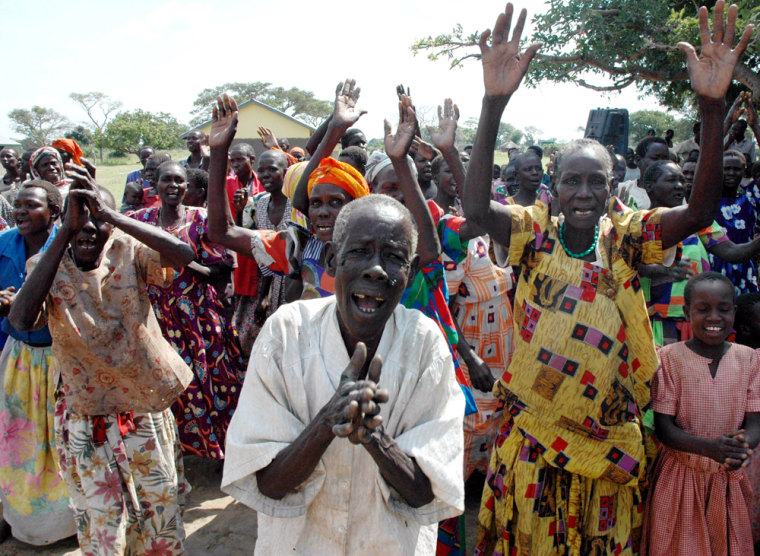A cease-fire between Uganda’s government and a shadowy rebel movement that has terrorized this east African nation for nearly two decades went into effect Tuesday.
The truce signed Saturday is aimed at ending the brutal war between the government and the rebel Lord’s Resistance Army, notorious for cutting off the tongues and lips of innocent civilians, enslaving thousands of children, and driving nearly 2 million people from their homes.
“The cessation of hostilities is in effect now and involves the (Ugandan army) halting their search and destroy operations,” said army Maj. Felix Kulaije. “From today, troops can only shoot in defense of civilians.”
Under the truce, rebels have three weeks to gather at two assembly points in largely uninhabited areas across the border in southern Sudan, where they will be protected and monitored.
“We don’t expect to hear any gunfire in these areas,” said Deputy Defense Minister Ruth Nankabirwa.
Chris Magezi, army spokesman for northern Uganda, said he does not expect a mass movement of rebel fighters right away. “The LRA do not have the confidence to move openly, so they will probably go secretively in groups on foot,” he said.
New peace for the region?
If the deal holds, it will be a major breakthrough in pacifying the African region that joins northern Uganda, eastern Congo and southern Sudan. Rebels from all three nations operated across borders with impunity for decades until a peace accord halted Congo’s civil war in 2003 and southern Sudanese rebels joined Sudan’s government in 2005.
Peace would open northern Uganda to greater oil and mineral exploration as well as allow hundreds of thousands of refugees to return to their farms.
Analysts with the International Crisis Group, which monitors conflict zones, said it was too early to tell whether the cease-fire will hold, but they were optimistic.
“This is the first formal, signed, negotiated and monitored cessation of hostilities agreement between the two sides brokered by a third party,” said David Mozersky, a regional analyst with the Brussels, Belgium-based think tank.
Brutal resistance
The Lord’s Resistance Army was formed from the remnants of a northern Uganda rebellion that began in 1986 after President Yoweri Museveni, a southerner, overthrew a brutal military junta.
Joseph Kony, leader of the Lord’s Resistance Army, mixed northern politics with religious mysticism, declaring himself a Christian prophet fighting to rule this country of 26 million people by the Ten Commandments.
U.N. officials estimate Kony’s guerrillas kidnapped 20,000 children in the past 19 years, turning the boys into soldiers and the girls into sex slaves for rebel commanders. Rebel attacks and atrocities drove 1.7 million people to flee.
The International Criminal Court has issued arrest warrants for Kony and four other rebel leaders, but the Ugandan government has promised not to turn them over in return for an end to the insurgency, which has killed thousands of civilians. An exact death toll is not known.
Human rights groups have condemned Museveni’s amnesty offer, but the president argues peace is more important than an international trial.
Amnesty terms
Under terms of the truce, Kony and three other top commanders wanted by the international court are to assemble along with their fighters, the group’s top negotiator said Sunday. Kony will likely head to the Ri-Kwangba assembly point in Western Equatoria State, on the western side of the Nile, because it is the closest to his current base.
Kony, who has been seen in public only a handful of times during the insurgency, has said that he is innocent of the war crimes and crimes against humanity charges filed by the ICC.
The truce does not include details on disarming the rebels or integrating them into Ugandan society. Those terms will be part of a final accord to be negotiated at talks in Juba, Sudan, with leaders of Sudan’s southern region serving as mediators.
Teams of Ugandan officials, rebels and African Union-appointed military officers are to monitor the truce. They will report to the chief mediator, southern Sudan Vice President Riek Machar.
Little is known about the rebel movement’s strength. Estimates on the number of guerrillas range from 500 to 5,000. They are split into dozens of small groups that have raided villages for supplies and rarely fighting government troops directly. Some might not learn of the truce for days or weeks.
Magezi, the army spokesman, said he expected rebels to begin arriving in Owiny-ki-Bul, in southern Sudan’s Eastern Equatoria state, in about a week. Owiny-ki-Bul is about 20 miles from the border and on the eastern side of the Nile.
